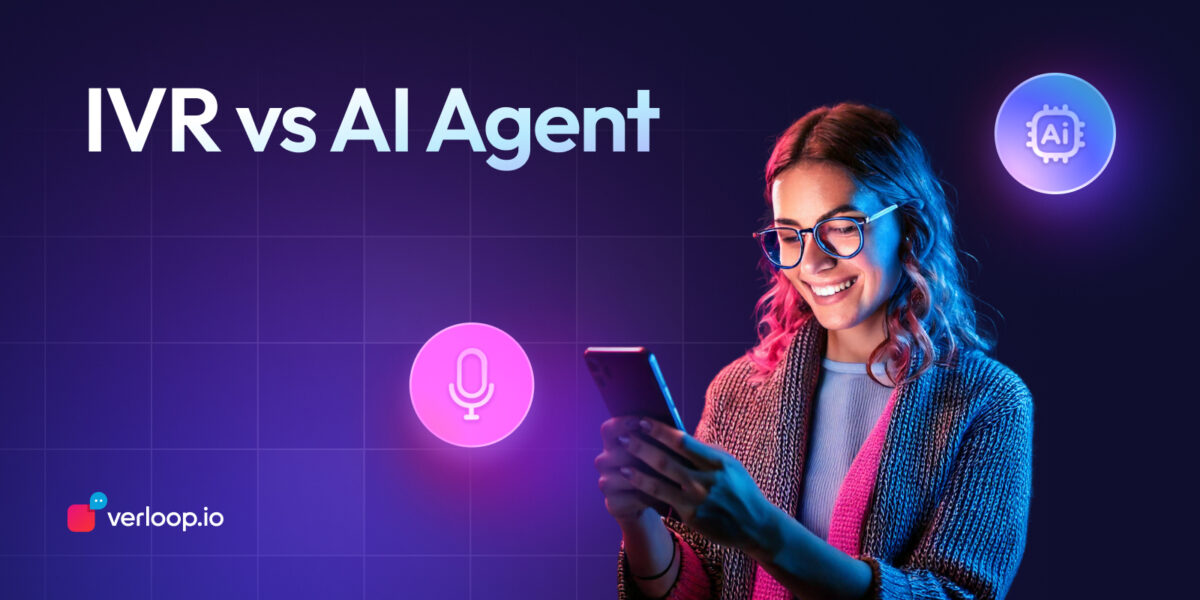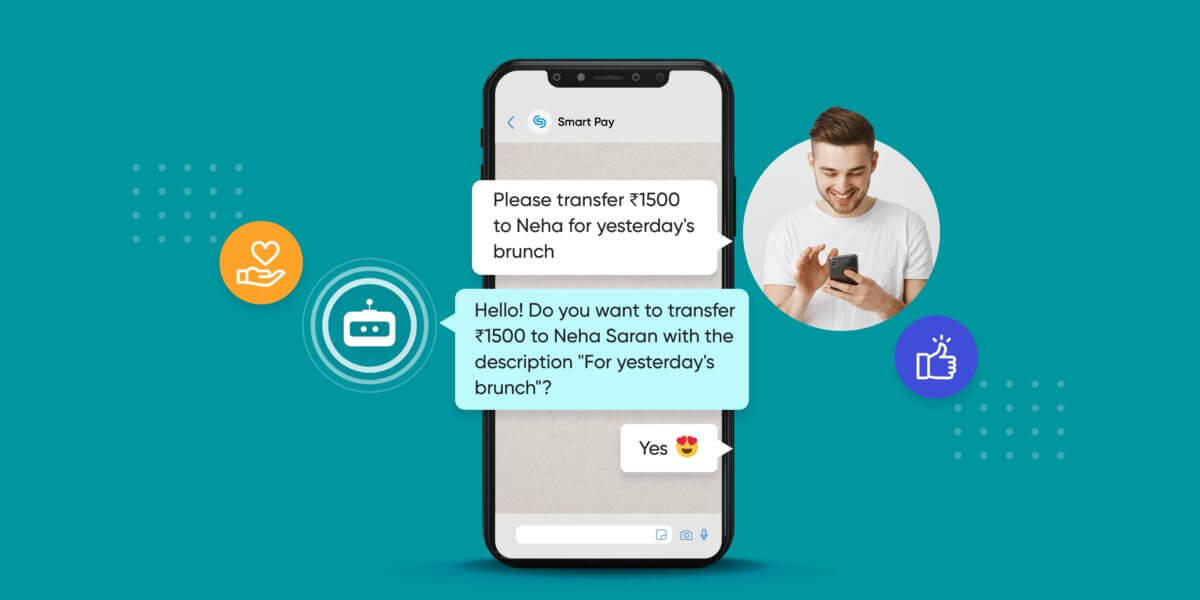
Voice AI Agent vs IVR
- September 1st, 2025 / 5 Mins read
-
Aarti Nair
Difference Between AI Agent and IVR
Phone support has been around for decades, and despite the rise of chat, email, and social channels, it’s still the first choice for many customers. But here’s the catch—what happens when that call begins with “Press 1 for Sales, Press 2 for Support” and a never-ending maze of options? For most, the answer is frustration and a high chance of hanging up before they even reach a human.
This is the world of IVR (Interactive Voice Response) systems—reliable, scalable, but often impersonal and rigid. They served businesses well when automation simply meant call routing. But today’s customers expect more than being bounced around menus; they expect conversations that feel natural, fast, and personalised.
That’s where Voice AI Agents enter the picture. Powered by Automatic Speech Recognition (ASR), Natural Language Processing (NLP), and contextual understanding, Voice AI Agents don’t just guide customers through menus—they listen, understand intent, and respond like a human. They can resolve queries, adapt to context, and seamlessly hand over to agents when needed.
So, which one makes sense for your business: the tried-and-tested IVR or the intelligent, human-like Voice AI Agent? Let’s break down both, compare their strengths and weaknesses, and understand why Voice AI is becoming the preferred choice for enterprises that value customer experience.
What is IVR?
IVR has been the backbone of customer phone support for decades. If you’ve ever called your bank and been greeted with “Press 1 for balance inquiries, Press 2 for card services, Press 3 to speak with an agent,” you’ve already experienced IVR. It was one of the earliest attempts to automate customer service at scale.
At its simplest, IVR is a system that connects callers to the right department or information without needing a live human operator. It relies on pre-recorded voice prompts and DTMF tones (the sound you hear when pressing numbers on your keypad). Some modern IVRs also include limited voice recognition, but the experience is still mostly menu-driven.
How IVR Works in Practice?
Here’s what a typical IVR flow looks like:
A customer dials a business helpline.
The IVR system plays a pre-recorded menu of options: “Press 1 for billing, Press 2 for support…”
The customer responds either by pressing a number or speaking a short phrase.
Based on that input, the IVR either delivers basic information (like account balance) or routes the call to the right human agent.
This setup is efficient for businesses because it reduces the need for operators to manually transfer calls. But for the customer, it often feels like navigating a maze—one wrong input can mean starting the entire process over again.
Where IVR Is Widely Used?
Over the years, IVR has found its place in industries that deal with high call volumes and repetitive queries:
Banking and Finance: Checking balances, activating cards, loan status inquiries.
Telecom Providers: Plan updates, bill payments, network troubleshooting.
Utilities: Paying electricity or water bills, reporting outages.
Healthcare: Scheduling appointments, refilling prescriptions, lab result inquiries.
The common thread? These are industries where customers often want quick answers to simple questions, and businesses want to automate routine tasks.
Why Businesses Still Use IVR?
Despite its reputation for being clunky, IVR continues to be widely adopted because of its benefits:
Cost-effective: A single IVR can handle thousands of calls simultaneously, reducing the need for large call centre teams.
Scalable: Businesses can add or adjust menu options without overhauling the system.
Always available: Customers can get basic information any time of day, even when agents are offline.
The Catch with IVR
While IVR solved the problem of handling large call volumes, it has struggled to keep up with changing customer expectations. Today’s customers don’t just want options—they want conversations. They expect the system to understand intent, adapt to context, and provide immediate answers without making them press through five layers of menus.
This is exactly where IVR begins to fall short—and why Voice AI Agents are becoming the next step in the evolution of automated customer service.
What is a Voice AI Agent?
If IVR was designed to give customers a list of options, a Voice AI Agent is designed to hold a conversation. Instead of forcing you to “press 1 for billing” or “press 2 for support,” a Voice AI Agent can understand when you say, “I want to check my last transaction” or “Can I change my delivery slot to Friday?”
At its core, a Voice AI Agent is an AI-powered virtual assistant that listens, understands, and responds to natural human speech in real time. It’s built on a stack of technologies such as:
Automatic Speech Recognition (ASR): Converts spoken words into text with high accuracy, even across accents, dialects, or background noise.
Natural Language Processing (NLP) and Natural Language Understanding (NLU): Go beyond words to understand context, meaning, and intent. If a customer says, “I lost my card and need help,” the AI doesn’t just hear “lost” or “card”—it understands the urgency and the next step needed.
Contextual Memory: Remembers previous parts of the conversation so interactions feel natural. For example, if a customer first asks about delivery charges and then says, “And what about Sunday delivery?” the agent knows they’re still talking about shipping.
Sentiment Analysis: Detects tone and emotion—whether a caller sounds frustrated, confused, or calm—and adapts responses accordingly.
Agent Handoff: Recognises when an issue is too complex for automation and seamlessly transfers the conversation to a human agent without the customer having to repeat themselves.
Where Voice AI Agents Are Already Making a Difference
Voice AI Agents are no longer futuristic concepts; they’re transforming industries right now:
Banking & Finance: Helping customers check balances, block lost cards, or guide them through loan applications in natural language.
E-commerce & Retail: Answering delivery status queries, processing refunds, and suggesting related products in real time.
Healthcare: Scheduling appointments, reminding patients about medications, and providing pre-screening before connecting them to doctors.
Travel & Hospitality: Managing flight bookings, rescheduling hotel check-ins, or handling loyalty points queries without making travellers wait.
Unlike IVR, which provides a linear and rigid menu-driven journey, Voice AI Agents adapt to the flow of conversation. They don’t just save time—they improve customer experience by making interactions more human, efficient, and personal.
And that’s why more businesses are asking: If IVR was the past, are Voice AI Agents the future?
Voice AI Agent vs IVR: Key Differences
Both IVR and Voice AI Agents aim to make customer service faster and more efficient. But the way they achieve this—and the experience they deliver—are worlds apart. Think of IVR as giving customers a map of options, while Voice AI Agents act more like a guide who walks alongside them.
User Experience
IVR offers a rigid, menu-driven journey. Customers must follow instructions step by step, which often feels slow and frustrating if they misclick or their need doesn’t fit neatly into a menu option. Voice AI Agents, on the other hand, create a conversational experience. Customers can speak naturally, ask follow-up questions, and get answers without being forced through layers of menus.
Flexibility
IVR responses are static—they do what they’re programmed to do and nothing more. Voice AI Agents are dynamic. They use contextual understanding to adapt in real time, even if customers phrase questions differently. For example, whether a caller says “I lost my card” or “My debit card is missing,” a Voice AI Agent will know both mean the same thing.
Efficiency
With IVR, efficiency comes from routing calls to the right department, but resolution usually still depends on a human agent. Voice AI Agents go a step further: they can resolve many queries themselves, escalate only when necessary, and hand over seamlessly without forcing the customer to repeat details.
Personalisation
IVR is a one-size-fits-all system. Every caller hears the same menu, regardless of their history with the company. Voice AI Agents can integrate with CRMs and backend systems, offering tailored responses. A customer asking about delivery doesn’t just hear “Track your order here”—the agent can say, “Your package is already in transit and will arrive by Thursday.”
Scalability
IVR handles volume but struggles with complexity. As menus grow, they become harder for both businesses to manage and for customers to navigate. Voice AI Agents scale effortlessly, learning from interactions and adapting to new scenarios without requiring businesses to redesign entire menu trees.
| Feature | IVR (Interactive Voice Response) | Voice AI Agent |
|---|---|---|
| User Experience | Menu-driven, rigid navigation | Natural, conversational interactions |
| Flexibility | Static, rule-based responses | Adaptive, context-aware responses |
| Efficiency | Routes calls but depends on agents for resolution | Resolves queries in real time; escalates only when needed |
| Personalisation | Same menu for all callers | Tailored responses using CRM and customer history |
| Scalability | Handles volume but limited by menu design | Scales across use cases, learns and improves with time |
Challenges with IVR
IVR may have been revolutionary when it first came along, but in today’s world of instant, personalised service, its cracks are hard to ignore. Customers are no longer willing to tolerate long menus, robotic experiences, or being passed around before finding help. Let’s look at the main challenges businesses face with IVR:
1. Complex Menus and Navigation
The more a business grows, the more layers get added to the IVR system. What starts as “Press 1 for billing, Press 2 for support” quickly becomes a labyrinth of submenus. Customers get frustrated when they have to listen through five options just to reach the right one—or worse, end up pressing the wrong key and restarting the process.
2. Lack of Personalisation
IVR treats every caller the same. Whether it’s a loyal customer calling for the tenth time or a new lead reaching out for the first, they’re both routed through the same impersonal menu. There’s no recognition of past interactions or ability to tailor the conversation to individual needs.
3. Limited Problem-Solving Ability
At best, IVR can route a call or give static information like account balance or business hours. Anything beyond that typically requires escalation to a human agent. This makes it inefficient for modern customer expectations, where callers want answers in one conversation—not after multiple transfers.
4. Higher Drop-Off Rates
Studies have shown that over 60% of customers abandon calls midway if they get stuck in an IVR system. Long wait times, confusing menus, and irrelevant options push them to hang up. That means lost opportunities, poor customer satisfaction, and sometimes even churn.
5. Frustration with Speech Recognition
While some IVRs attempt basic speech recognition, it’s often clunky and inaccurate. Accents, background noise, or simply phrasing things differently can confuse the system. Few things irritate a caller more than being told, “Sorry, I didn’t get that. Please say it again,” multiple times.
6. Limited Insights for Businesses
Because IVR is largely rule-based, it doesn’t generate deep insights into customer needs. Businesses can track how many calls were routed, but they don’t get a clear picture of why customers are calling, where friction occurs, or how to improve the overall journey.
In short, IVR often saves costs for businesses but at the expense of customer experience. And in a world where experience directly impacts loyalty, that trade-off is no longer sustainable. This is exactly why companies are turning to Voice AI Agents as the smarter, more human alternative.
Benefits of Voice AI Agents
Where IVR leaves customers frustrated, Voice AI Agents step in to transform the experience. They don’t just replace menu trees with smarter tech—they reimagine what customer conversations can look like. Here’s how they make the difference:
1. Conversational and Natural Interactions
Instead of forcing customers through long menus, Voice AI Agents let people speak in their own words. A caller can simply say, “I’d like to reschedule my flight,” and the AI understands the request. This makes the process faster, smoother, and more human-like—reducing call drop-offs and frustration.
2. Personalised Support at Scale
By connecting directly to CRMs and backend systems, Voice AI Agents can instantly access customer history. So instead of hearing the same generic prompts, a returning customer might hear, “Hi Aarti, I see your last order was delayed—would you like an update on that?” Personalisation like this builds loyalty while cutting down on repetitive back-and-forth.
3. Real-Time Problem Solving
Voice AI Agents are not limited to routing calls. They can check balances, update delivery dates, reset passwords, or even guide customers through loan applications—all within the same call. Complex queries can still be escalated to a human agent, but only after the AI has done the heavy lifting.
4. Lower Wait Times and Higher Efficiency
Because Voice AI Agents handle routine queries directly, customers don’t have to wait endlessly for a human agent. This frees up agents to focus on complex, high-value conversations. Businesses, in turn, save costs while improving customer satisfaction.
5. Smarter Insights for Businesses
Every interaction with a Voice AI Agent generates valuable data. From understanding what customers are asking most often to detecting frustration in tone, businesses can uncover trends and refine their support strategy. Unlike IVR, which only logs call routing, Voice AI provides actionable insights.
6. Multilingual and Emotion-Aware
Unlike traditional IVR systems that struggle with accents or limited commands, modern Voice AI Agents support multiple languages and dialects. They also pick up on sentiment—knowing when a customer sounds upset or stressed—and can adjust their tone or escalate accordingly.
In essence, Voice AI Agents combine the efficiency of automation with the empathy of human-like interaction. They reduce costs for businesses, improve experiences for customers, and create a win-win scenario where both sides feel heard and supported.
When Should AI Hand Over to a Human Agent?
As advanced as Voice AI Agents are, they aren’t meant to replace human agents entirely. Their true strength lies in knowing when to step aside and let a person take over. Customers value speed and efficiency, but they also want empathy and nuanced judgment in the right moments.
1. Complex or Escalated Issues
When a query goes beyond structured workflows—for example, a legal dispute over an insurance claim or a highly technical troubleshooting case—human intervention is necessary. A Voice AI Agent can gather details upfront but should seamlessly pass the case to a specialist who can resolve it.
2. Emotionally Sensitive Conversations
Sometimes, what matters isn’t just solving the problem but showing compassion. A customer reporting a fraud attempt, a cancelled trip, or a medical emergency may not want to interact with automation. Voice AI Agents that detect frustration or distress should immediately hand off to human agents who can provide reassurance.
3. Exceptions and Edge Cases
Every system has outliers—scenarios that weren’t anticipated during setup. When a customer asks something the AI can’t interpret confidently, forcing automation risks creating more frustration. A smooth handover ensures the issue is resolved without repetition.
4. Customer Preference
Some customers simply prefer to talk to a person, no matter how advanced the AI may be. Giving them the option to escalate early preserves trust and ensures the business is seen as customer-first, not automation-first.
5. Relationship-Driven Conversations
In industries like banking, healthcare, or B2B services, some interactions go beyond transactions—they’re about building long-term trust. Here, Voice AI can play the role of assistant by collecting details, while human agents step in to nurture the relationship.
The best Voice AI platforms don’t aim to replace human agents—they aim to augment them. By filtering out routine queries and intelligently handing over the complex, emotional, or relationship-driven ones, businesses can deliver service that is both scalable and deeply human.
Learn more about human handover here.
Making the Right Choice for the Future of Customer Support
IVR systems had their time and place. They automated call routing, reduced human dependency, and set the stage for scaled phone support. But in today’s world, where customers expect instant, personalised, and empathetic experiences, IVR feels like a relic of the past.
Voice AI Agents bring conversations to life. They listen, understand, and respond in natural language. They reduce wait times, resolve routine issues instantly, and know when to hand over to human agents for complex or sensitive queries. It’s not just automation—it’s customer support that adapts in real time.
For businesses, this means more than cost savings. It means higher CSAT scores, improved efficiency, and stronger customer loyalty. Customers walk away not just with answers, but with the sense that they’ve been understood.
At the end of the day, the question isn’t whether Voice AI Agents will replace IVR. It’s whether your business is ready to meet the new expectations of your customers.
Ready to see how Verloop.io’s Voice AI Agent can make every customer call faster, smarter, and more human?
Schedule a demo today and discover the future of voice support.
FAQs: Voice AI Agent vs IVR
1. What is the difference between IVR and Voice AI Agents?
IVR (Interactive Voice Response) is a menu-driven system that lets callers interact through keypad inputs or basic voice commands. Voice AI Agents, on the other hand, use speech recognition, NLP, and contextual understanding to hold natural conversations, resolve issues in real time, and escalate to human agents when needed.
2. Why are businesses moving from IVR to Voice AI Agents?
Customers today expect faster, more personalised service. IVR often frustrates users with long menus and limited options, while Voice AI Agents deliver instant, conversational support that adapts to context. This shift improves efficiency, customer satisfaction, and loyalty.
3. Can Voice AI Agents completely replace human agents?
No. The best Voice AI solutions augment, not replace, human agents. They handle routine queries, reduce workloads, and seamlessly hand off complex or emotional cases to humans. This hybrid approach ensures both speed and empathy in customer interactions.
4. Are Voice AI Agents more expensive than IVR?
While the upfront cost of implementing Voice AI may be higher than traditional IVR, the long-term ROI is greater. Voice AI Agents reduce drop-offs, cut handling times, and improve resolution rates, which translate into cost savings and better customer retention.
5. How does Verloop.io’s Voice AI Agent stand out?
Verloop.io’s Voice AI Agent combines advanced ASR, NLP, speech normalisation, and sentiment detection to make conversations more human-like. It integrates with CRMs and backend systems for real-time personalisation and offers seamless agent handoff—helping businesses deliver support that feels both scalable and empathetic.







